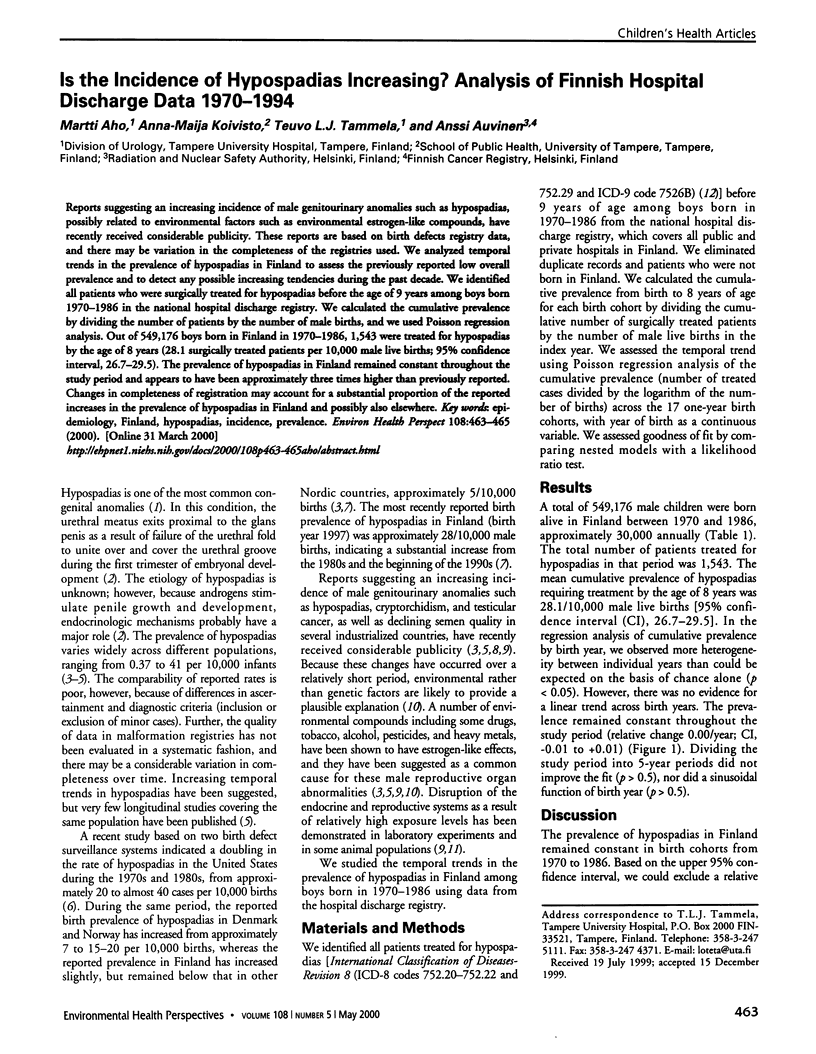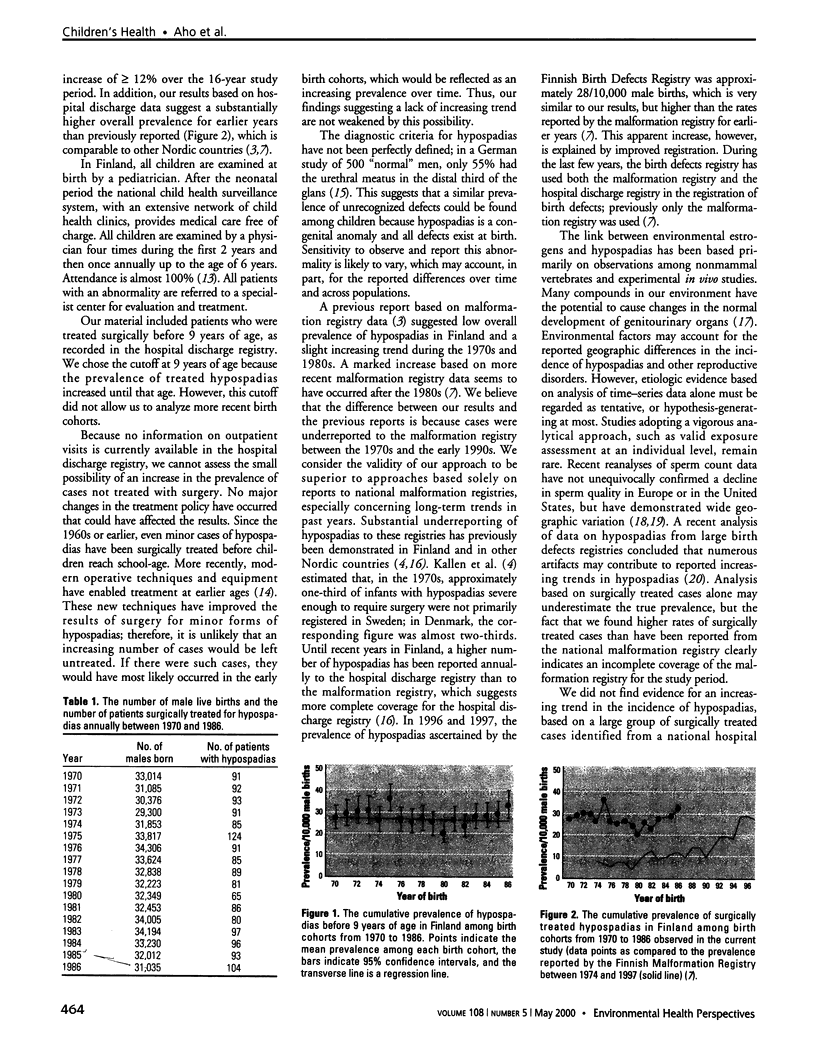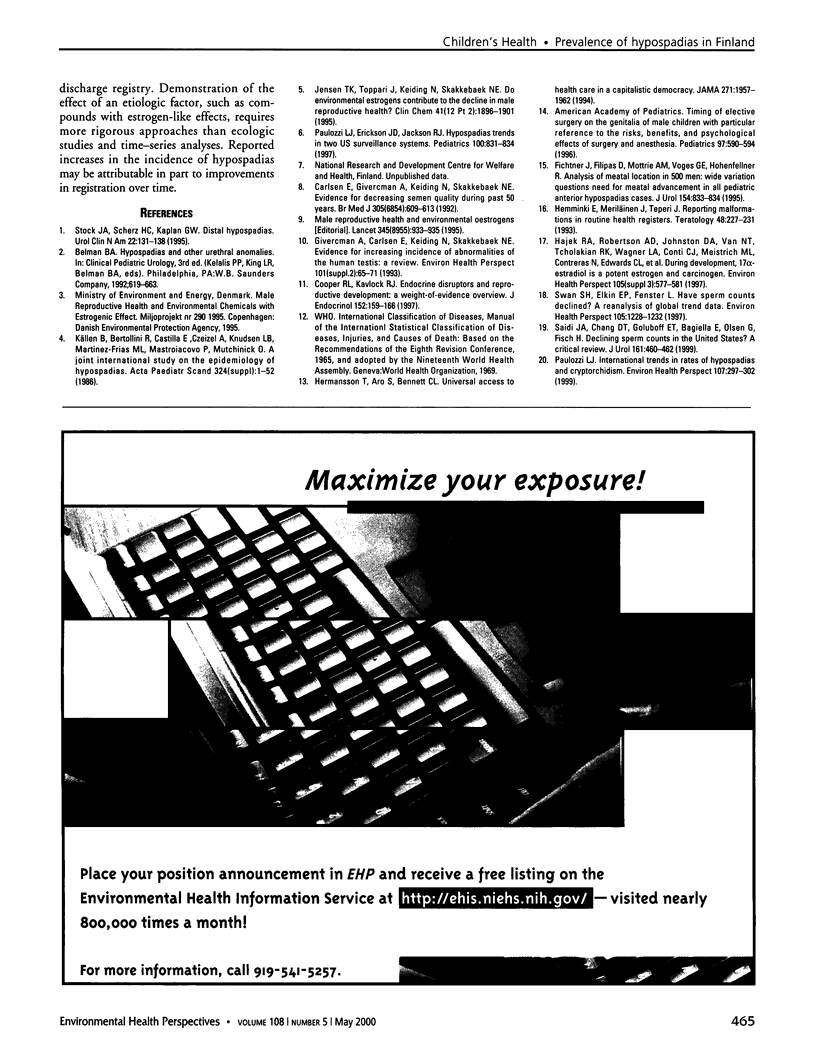Abstract
Reports suggesting an increasing incidence of male genitourinary anomalies such as hypospadias, possibly related to environmental factors such as environmental estrogen-like compounds, have recently received considerable publicity. These reports are based on birth defects registry data, and there may be variation in the completeness of the registries used. We analyzed temporal trends in the prevalence of hypospadias in Finland to assess the previously reported low overall prevalence and to detect any possible increasing tendencies during the past decade. We identified all patients who were surgically treated for hypospadias before the age of 9 years among boys born 1970-1986 in the national hospital discharge registry. We calculated the cumulative prevalence by dividing the number of patients by the number of male births, and we used Poisson regression analysis. Out of 549,176 boys born in Finland in 1970-1986, 1,543 were treated for hypospadias by the age of 8 years (28.1 surgically treated patients per 10,000 male live births; 95% confidence interval, 26.7-29.5). The prevalence of hypospadias in Finland remained constant throughout the study period and appears to have been approximately three times higher than previously reported. Changes in completeness of registration may account for a substantial proportion of the reported increases in the prevalence of hypospadias in Finland and possibly also elsewhere.
Full text
PDF


Images in this article
Selected References
These references are in PubMed. This may not be the complete list of references from this article.
- Carlsen E., Giwercman A., Keiding N., Skakkebaek N. E. Evidence for decreasing quality of semen during past 50 years. BMJ. 1992 Sep 12;305(6854):609–613. doi: 10.1136/bmj.305.6854.609. [DOI] [PMC free article] [PubMed] [Google Scholar]
- Cooper R. L., Kavlock R. J. Endocrine disruptors and reproductive development: a weight-of-evidence overview. J Endocrinol. 1997 Feb;152(2):159–166. doi: 10.1677/joe.0.1520159. [DOI] [PubMed] [Google Scholar]
- Fichtner J., Filipas D., Mottrie A. M., Voges G. E., Hohenfellner R. Analysis of meatal location in 500 men: wide variation questions need for meatal advancement in all pediatric anterior hypospadias cases. J Urol. 1995 Aug;154(2 Pt 2):833–834. [PubMed] [Google Scholar]
- Giwercman A., Carlsen E., Keiding N., Skakkebaek N. E. Evidence for increasing incidence of abnormalities of the human testis: a review. Environ Health Perspect. 1993 Jul;101 (Suppl 2):65–71. doi: 10.1289/ehp.93101s265. [DOI] [PMC free article] [PubMed] [Google Scholar]
- Hajek R. A., Robertson A. D., Johnston D. A., Van N. T., Tcholakian R. K., Wagner L. A., Conti C. J., Meistrich M. L., Contreras N., Edwards C. L. During development, 17alpha-estradiol is a potent estrogen and carcinogen. Environ Health Perspect. 1997 Apr;105 (Suppl 3):577–581. doi: 10.1289/ehp.97105s3577. [DOI] [PMC free article] [PubMed] [Google Scholar]
- Hemminki E., Meriläinen J., Teperi J. Reporting of malformations in routine health registers. Teratology. 1993 Sep;48(3):227–231. doi: 10.1002/tera.1420480306. [DOI] [PubMed] [Google Scholar]
- Hermanson T., Aro S., Bennett C. L. Finland's health care system. Universal access to health care in a capitalistic democracy. JAMA. 1994 Jun 22;271(24):1957–1962. [PubMed] [Google Scholar]
- Jensen T. K., Toppari J., Keiding N., Skakkebaek N. E. Do environmental estrogens contribute to the decline in male reproductive health? Clin Chem. 1995 Dec;41(12 Pt 2):1896–1901. [PubMed] [Google Scholar]
- Källén B., Bertollini R., Castilla E., Czeizel A., Knudsen L. B., Martinez-Frias M. L., Mastroiacovo P., Mutchinick O. A joint international study on the epidemiology of hypospadias. Acta Paediatr Scand Suppl. 1986;324:1–52. doi: 10.1111/j.1651-2227.1986.tb14935.x. [DOI] [PubMed] [Google Scholar]
- Paulozzi L. J., Erickson J. D., Jackson R. J. Hypospadias trends in two US surveillance systems. Pediatrics. 1997 Nov;100(5):831–834. doi: 10.1542/peds.100.5.831. [DOI] [PubMed] [Google Scholar]
- Paulozzi L. J. International trends in rates of hypospadias and cryptorchidism. Environ Health Perspect. 1999 Apr;107(4):297–302. doi: 10.1289/ehp.99107297. [DOI] [PMC free article] [PubMed] [Google Scholar]
- Saidi J. A., Chang D. T., Goluboff E. T., Bagiella E., Olsen G., Fisch H. Declining sperm counts in the United States? A critical review. J Urol. 1999 Feb;161(2):460–462. [PubMed] [Google Scholar]
- Stock J. A., Scherz H. C., Kaplan G. W. Distal hypospadias. Urol Clin North Am. 1995 Feb;22(1):131–138. [PubMed] [Google Scholar]
- Swan S. H., Elkin E. P., Fenster L. Have sperm densities declined? A reanalysis of global trend data. Environ Health Perspect. 1997 Nov;105(11):1228–1232. doi: 10.1289/ehp.971051228. [DOI] [PMC free article] [PubMed] [Google Scholar]




